Carbon Materials
Synthetic Graphite
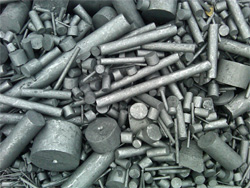 Is primarily the result of Electrode manufacturing. These electrodes carry the electricity that heats electric arc furnaces, the vast majority steel furnaces. They are made from petroleum coke after it is mixed with petroleum pitch, extruded and shaped, then baked to sinter it, and then graphitized by heating it above the temperature (3000 °C) that converts carbon to graphite. They can vary in size up to 11 ft. long and 30 in. in diameter.
Is primarily the result of Electrode manufacturing. These electrodes carry the electricity that heats electric arc furnaces, the vast majority steel furnaces. They are made from petroleum coke after it is mixed with petroleum pitch, extruded and shaped, then baked to sinter it, and then graphitized by heating it above the temperature (3000 °C) that converts carbon to graphite. They can vary in size up to 11 ft. long and 30 in. in diameter.
Powder and scrap The powder is made by heating powdered petroleum coke above the temperature of graphitization. The graphite scrap comes from pieces of unusable electrode material (in the manufacturing stage or after use) and lathe turnings, usually after crushing and sizing. Most synthetic graphite powder goes for carbon raisers in foundries and steel plants. Synthetic graphite is processed at ultra high temperatures, and impurities contained in the precursor carbons are significantly reduced in concentration during processing. This occurs as a result of the high temperature vaporization of volatile impurities, which at the process temperatures utilized includes most metal oxides, sulfur, nitrogen, hydrogen, and all organic components that were part of the original petroleum or coal tar pitch. Synthetic graphite is essentially the most chemically pure form of carbon available.
Anthracite Coal
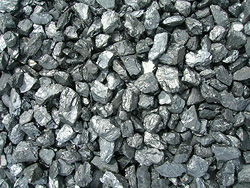 Anthracite coal has the highest carbon count and contains the fewest impurities of all coals, and has the highest calorific content as compared to other types of coals such as bituminous coal and lignite. Anthracite coal is a hard mineral coal that has the highest luster and lowest impurities of all coals. It is the cleanest variety of coals.
Anthracite coal has the highest carbon count and contains the fewest impurities of all coals, and has the highest calorific content as compared to other types of coals such as bituminous coal and lignite. Anthracite coal is a hard mineral coal that has the highest luster and lowest impurities of all coals. It is the cleanest variety of coals.
Anthracite is the most metamorphosed type of coal it's carbon content is between 92.1% and 98%. The term is applied to those varieties of coal which do not give off tarry or other hydrocarbon vapors when heated below their point of ignition. Anthracite burns with a short, blue, and smokeless flame.
Anthracite may be considered to be a transition stage between ordinary bituminous and graphite, produced by the more or less complete elimination of the volatile constituents of the former, and it is found most abundantly in areas that have been subjected to considerable earth-movements, such as the flanks of great mountain ranges.
With the growth of mini-mill's increasing need for higher quality materials in the (EAF) Electric Arc Furnace anthracite coal has become the injection carbon of choice for the top EAF steel plants. Because scrap metal is the primary source of metal in the EAF there have been a limited variety of finished products a mini-mill could produce. DRI pellets and other iron ore based materials have been substituting or supplementing traditional scrap allowing for a greater variety of finished products produced in the EAF. As a result of the use of these materials only the cleanest, lowest sulfur, anthracite injection carbons can be used. Anthracite is among the lowest sulfur materials available for injection and is the most environmentally friendly material due to its purity.
Metallurgical Coke
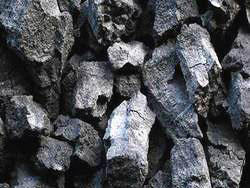 Coke is a solid carbonaceous residue derived from low-ash, low-sulfur bituminous coal from which the volatiles are driven off by heating without oxygen at temperatures as high as 1,000 °C (1,832 °F) so that the fixed carbon and residual ash are liquefied and fused together. Metallurgical coke is used as a fuel and as a reducing iron ore to iron in the blast furnace. The product is cast iron and is too rich in dissolved carbon, and so the carbon is reduced next in the steelmaking process.
Coke is a solid carbonaceous residue derived from low-ash, low-sulfur bituminous coal from which the volatiles are driven off by heating without oxygen at temperatures as high as 1,000 °C (1,832 °F) so that the fixed carbon and residual ash are liquefied and fused together. Metallurgical coke is used as a fuel and as a reducing iron ore to iron in the blast furnace. The product is cast iron and is too rich in dissolved carbon, and so the carbon is reduced next in the steelmaking process.
The coke must be strong enough to resist the weight of overburden in the blast furnace, or cupola in a foundry application which is why coking coal is so important in making hot metals by the conventional route. The trend is the alternative to coke or DRI (direct reduced iron) which is typically higher in sulfur causing the rising demand of low sulfur carbons (anthracite coal) in the remaining steelmaking process. Coke from coal is grey, hard, and porous and has an extremely high heating value. Some cokemaking processes produce valuable by-products that include coal tar, ammonia, light oils, and "coal gas".
The most commonly used metallurgical coke is “met-coke breeze” for foundries and steel plants. Met coke breeze is the result of screening Metallurgical coke so as to reduce the restriction of air flow through the lumps when used in the blast furnace or cupola and to ensure the cokes ability to become hot incandescent red and melt or reduce the iron ore or scrap present in the furnace.
Coke breeze is very similar to anthracite coal in chemistry but has lower volatiles and slightly higher fixed carbon values. One of the drawbacks of coke breeze to anthracite is that met-coke is more abrasive and may cause wear problems in the elbow areas of pneumatic conveying systems. This is typically overcome by blending the met-coke with other carbons to reduce the wear considerably.
Petroleum Coke
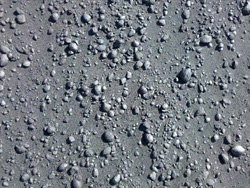 Petroleum coke (pet-coke) is a carbonaceous solid derived from oil refinery coker units or other cracking processes. Non petroleum based cokes are made from coal.
Petroleum coke (pet-coke) is a carbonaceous solid derived from oil refinery coker units or other cracking processes. Non petroleum based cokes are made from coal.
Marketable (non power plant grades) coke is coke that is essentially pure carbon and can be sold for use as fuel, or for the manufacture of dry cells, electrodes, etc. (i.e., anode grade coke). Needle coke, also called acicular coke, is a highly crystalline petroleum coke used in the production of electrodes for the steel and aluminium industries and is particularly valuable because the electrodes must be replaced regularly and Needle coke is produced exclusively from sweet crude oil[citation needed], which is in diminishing supply.
Fuel Grade Coke is classified as either sponge coke or shot coke morphology. In general, lower temperatures and higher pressures promote sponge coke formation Oil refineries have been producing coke for well over 100 years.
Its high heat and low ash content make it an excellent carbon additive but petroleum coke is high in sulfur and low in volatile content which pose some environmental and technical problems with its combustion. This has also caused a great deal of demand for anthracite coal in order to meet current North American emissions standards.
Calcined petroleum coke (CPC) is the product from calcining petroleum coke. This coke is the product of the coker unit in a crude oil refinery. The calcined petroleum coke is used to make anodes for the aluminium, steel and titanium smelting industry. The green coke must have sufficiently low metals content in order to be used as anode material. Green coke with this low metals content is referred to as anode grade coke. The green coke with too high metals content will not be calcined and is used for burning. This green coke is called fuel grade coke. Calcined pet-coke has increasingly grown in price making it almost obsolete as more economical lower sulfur alternatives are available for iron and steel making.
Pitch Coke
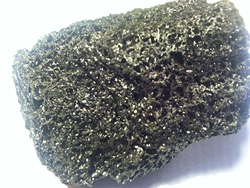 A by-product of coal gas manufacture.
A by-product of coal gas manufacture.
Pitch coke is a high purity carbon residue created by coking coal tar pitch either by itself or in conjunction with other carbons when manufacturing carbonaceous products. Coal tar pitch is a by-product resulting from the thermal distillation of bituminous coal or graphite manufacturing. Because it is condensed from the gas phase, coal tar pitch is inherently low in ash, metals, and other non-carbonaceous substances. Pitch coke is extremely high in carbon and low in impurities. Pitch coke has a lower density than other comparable carbons.
Coal tar pitch coke is a highly aromatic feedstock and is highly graphitizable. Pitch coke is also inherently low in sulfur and has relatively high thermal conductivity. With respect to almost everything but density pitch coke closely resembles graphite in a number of categories Pitch coke is of higher purity and lower sulfur than calcined pet-coke.
Calcined Anthracite
 Calcined Anthracite is manufactured by exposing high grade anthracite coal in various types of thermal or electrical ovens to temperatures as high as 2000 C, which results in some graphitic development in the finished product.
Calcined Anthracite is manufactured by exposing high grade anthracite coal in various types of thermal or electrical ovens to temperatures as high as 2000 C, which results in some graphitic development in the finished product.
When to compared to conventional no-calcined anthracite it has low moisture, volatile, and sulfur , hydrogen, and nitrogen content. Calcined coal has become a functional substitute for synthetic graphite in certain foundry and steel mill applications.
Electrically calcined anthracite is used in manufacturing certain electrodes, cathodes, Soderberg pastes, and carbon blocks.
Needle Coke
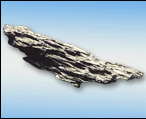 Needle coke, also called acicular coke, is a highly crystalline petroleum coke used in the production of electrodes for the steel and aluminium industries and is particularly valuable because the electrodes must be replaced regularly and Needle coke is produced exclusively from sweet crude and is only made in a few places throughout the world.
Needle coke, also called acicular coke, is a highly crystalline petroleum coke used in the production of electrodes for the steel and aluminium industries and is particularly valuable because the electrodes must be replaced regularly and Needle coke is produced exclusively from sweet crude and is only made in a few places throughout the world.
Needle coke has acicular morphology and tends to form oriented needle-like structures that are clearly visible to the naked eye. This unique morphology is a reflection of the high degree of liquid crystal alignment occurring when manufactured. This formation is consistent with a coke that is manufactured from highly aromatic character feedstock.
Needle coke is a highly crystalline form of carbon and has a high level of two-dimensional orientations except at the "c" axis direction. When heated to graphitization temperatures, "c" axis orientation is effected forming the highest quality synthetic graphite available.
Calcined needle coke is higher in carbon and lower in ash and metal than traditional calcined pet-coke. It has a better developed layer structure than standard calcined coke giving it unique friction and wearing properties. Calcined needle coke tends to also be softer in nature offering certain friction applications exacting performance characteristics.
Amorphous Graphite
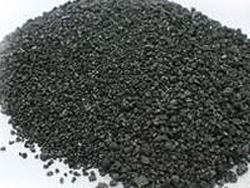 Amorphous graphite is formed by the thermal metamorphism of coal seams. Though crystalline in nature, its low degree of
crystalline order and very fine particle size make it appear
amorphous. It is usually of lower purity than the crystalline
flake graphite and, therefore, commands a lower price than its
crystalline counterpart.
Amorphous graphite is formed by the thermal metamorphism of coal seams. Though crystalline in nature, its low degree of
crystalline order and very fine particle size make it appear
amorphous. It is usually of lower purity than the crystalline
flake graphite and, therefore, commands a lower price than its
crystalline counterpart.
Amorphous graphite typically contains a higher ash content than other forms of natural graphite. The purity of commercially available material ranges from 60% to 85% carbon. Some amorphous graphite deposits produce material as high as 90% carbon. To the untrained eye a piece of amorphous graphite simply looks amorphous, like a lump of anthracite coal. However, it is much denser than anthracite, 2.2g/cc vs. 1.7g/cc, and is soft and lubricious..
Amorphous graphite is relatively low in sulfur and the higher carbon varieties can be used for carbon raiser applications in foundry and steel plants. It is soft, relatively easy to grind, withstands high temperatures making it a good material for mold washes, core washes, parting agents, and plumbago. It's primary application is for use in refractories.
Graphitized Coke
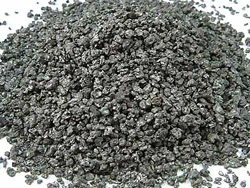 Made from only the highest quality petroleum coke, specifically engineered to provide consistency, repeatability, and less erratic performance.
A lot like synthetic graphite such as low ash, hi, and low sulfur. It has a lower density but has fissures which gives it a faster solution rate compared to standard synthetic graphite. Graphitized coke has slight economic advantages over standard high quality synthetic.
Made from only the highest quality petroleum coke, specifically engineered to provide consistency, repeatability, and less erratic performance.
A lot like synthetic graphite such as low ash, hi, and low sulfur. It has a lower density but has fissures which gives it a faster solution rate compared to standard synthetic graphite. Graphitized coke has slight economic advantages over standard high quality synthetic.
Other Carbons
- Graphite/Carbon Pellets
- Activated Carbon
- Expandable Graphite
- Amorphous Graphite
- Graphite Foil
- Graphite Lubricants
- Graphitized Petroleum Coke
- Graphite Shapes
- Graphite Electrodes
- Carbon Black
- Fluid Coke
- Shot Coke




